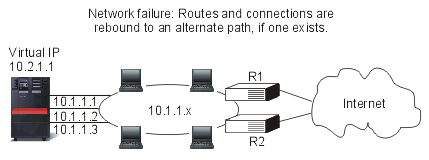Fault tolerance shows several different ways a route might be recovered after an outage.
Another use for virtual IP addresses is to protect against route fault tolerance.
This example shows several different ways a route can be recovered after an outage. The most reliable connection is when a virtual IP address is defined on the system. With virtual IP's support, even if an interface fails, the session can still communicate using different interfaces.

What happens if router R1 fails?
- Connections through R1 are rerouted through R2.
- The failed gateway will detect R1 recovery, but active connections will continue to run through R2.
What happens if interface 10.1.1.1 fails?
- Active connections to 10.1.1.1 are lost, but other connections to 10.1.1.2, 10.1.1.3, and 10.2.1.1 remain.
- Route rebinding:
- Pre-V4R2: Indirect routes are rebound to 10.1.1.2 or 10.1.1.3.
- V4R2: Routes are rebound only if Preferred Binding Interface is set to NONE.
- V4R3 and higher: You need to define 10.2.1.1 as the virtual IP address
and primary system address.
- The primary IP address of the system remains active.
- The system stays accessible as long as at least one physical interface remains active.